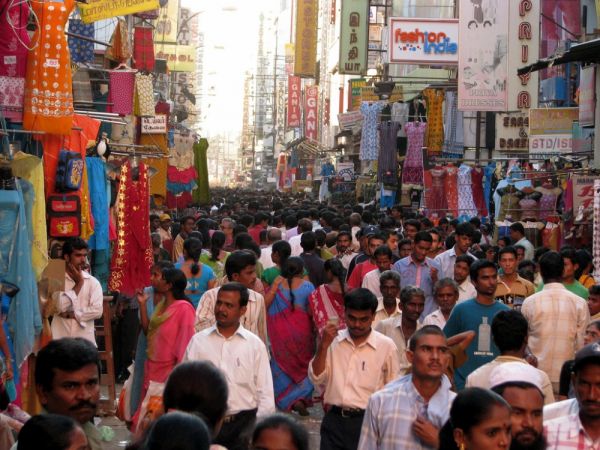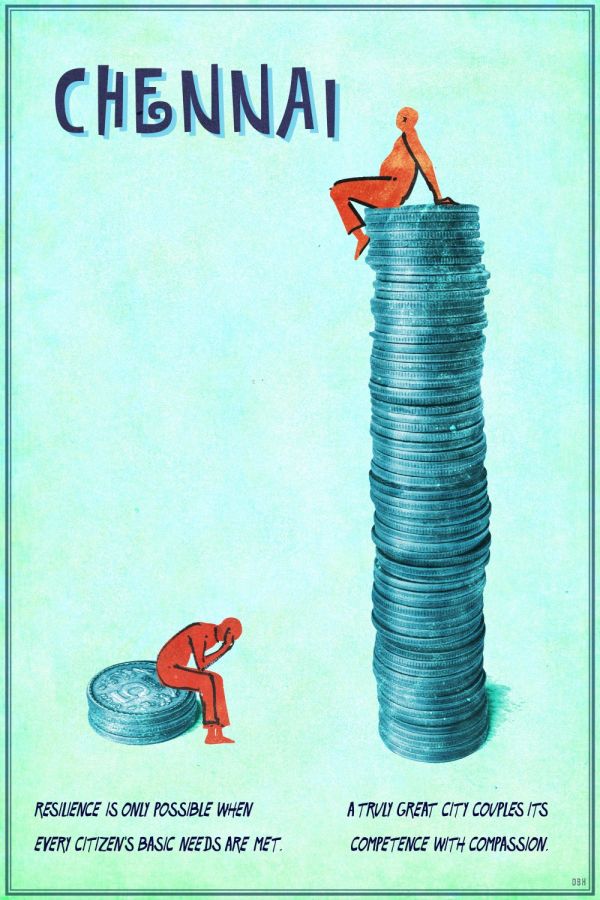Rich or Poor, Inclusive or Dysfunctional, Chennai’s Future Hangs in the Balance

Will Chennai be a city that caters only to the rich, or one that embraces all its citizens? Photo credit: McKay Savage
As the Informal City Dialogues moves toward its “Embracing the Informal City” conference in September, each week we will present summaries of the scenarios created in the six participating cities. These scenarios were created in multi-day workshops planned and conducted by Forum for the Future in conjunction with Transparent Chennai, and with support from The Rockefeller Foundation. The outputs were collaboratively envisioned by a wide range of actors, from informal settlers and street vendors to urban planners and government officials. The following is an excerpt from Forum for the Future’s report on the scenarios developed in each city, which will be published in September. Click here to read more about how the futures scenarios process works.

Illustration by Daniel Horowitz
Chennai
At the workshops in Chennai, four possible scenarios were imagined for the city’s future. In the first two, virtually all urban amenities, from housing to transportation to basic services, are geared toward the wealthy. But in one of these first two scenarios, government operates highly effectively (for those who can afford it, at least) while in the other it barely functions, prompting the rich to segregate themselves into gated communities with privatized services. Neither of these scenarios makes room for the poor or the informal, both of which are forced to the urban fringe.
The latter two scenarios look quite different. In both of these scenarios, the city’s poorer residents are considered every bit as legitimate as the rich. But one of these scenarios imagines an incompetent government — it cares about the poor but cannot adequately help them. In the other, however, effective government and a pro-poor agenda combine to create an inclusive city that allows for in-situ slum development and upwardly mobile informal employment.
Chennai Inc.
Chennai in 2040 is a city for the rich. They dominate the local government, which enacts policies for their benefit. The city is clean and efficient but has no room for the poor or the informal. In 2025, the slums were demolished to make room for shopping malls and high-rise buildings. Public spaces like parks and roads have been cleared of street vendors and the informal sector has been largely eliminated. Problems are outsourced to the private sector to solve and services including water, electricity, waste management, education, and healthcare have all been privatized. Service delivery is efficient and high-quality but unaffordable for the poor. They’ve been pushed to the edges of the city and now their only interaction with the wealthy is when they work as maids, cooks, or other household servants. Waste is sent offshore to be recycled and is no longer available for waste pickers to process.
Gated Chennai
In this scenario, Chennai’s government in 2040 is pro-rich, autocratic, and laissez faire. It is also inefficient and unable to deal with the needs of the growing city. The wealthy have ensconced themselves in luxurious gated communities that benefit from privatized services like clean water from desalination plants and high-quality health care. The poor are mostly confined to crowded and squalid settlements on the outskirts of the city that lack basic services. Unemployment and crime rates are high and there is a widespread sense of alienation. Public spaces and other amenities are scarce and poorly maintained. The government’s inability to manage waste has caused severe degradation of air and water, leading to widespread health problems—especially among those too poor to afford private hospitals. Waste from the gated communities is mostly dumped outside the city, preventing access to it by waste pickers.
Namma Metro
Chennai in 2040 is run by a government that has progressive policies but is highly ineffective. In this scenario, a radical leftist party took power in 2015 and has been in control ever since. The party has promoted pro-poor policies and is committed to providing public services but has a hard time delivering on its promises. Slums were officially recognized and legalized in 2020 and are now widespread throughout the city. However, conditions in the slums are poor, as the government is unable to effectively provide services to the rising population. Open spaces are scarce, as most of them now contain informal settlements. Waste management has been decentralized and provides income for waste pickers, but conditions are unhygienic and difficult. Ineffective waste management combined with climate change has caused extreme environmental degradation, including dangerous levels of air and water pollution. Disease is rampant and the poor quality of healthcare in government hospitals means that infant and maternal mortality rates are at an all-time high. The informal sector in 2040 accounts for more than half the workforce.
Rajnikanth
In this world, a transformation of Chennai began in 2014 with the implementation of a new kind of housing development called Samthuvam (“Equality”)—an in situ redevelopment of a slum guided by an inclusive and participatory process. The new development integrated people from different social and economic strata and sparked a revolution in attitudes and policies. By 2040, an efficient and pro-poor government is able to provide high-quality and affordable services to the people of the city—including universal healthcare and education, clean water, and a fair and efficient judicial system. The cityscape features high-rise buildings to house the growing population and consists of self-sustaining neighborhoods that benefit from community agriculture and localized waste treatment. Waste pickers have been able to transform themselves into community waste managers thanks a government-funded education program.









